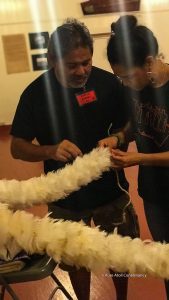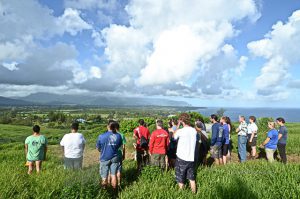by Mikiala Pescaia
NPS Interpretive Ranger and Education Specialist
Wewehi Mōkapu i ona lei hulu, a huhulu ana i ke ʻala lipoa,
E ala mai e nā hoa, nā hoa iō Ahiona
Ahiona i ka ʻai hāwane, i ka lau nape
Ahiona kīkaha a ʻiwa, i ka pae Kalawao
pae mai hoʻi nēia kama, i uka i ka ulu ʻāweoweo papa
pāpā ʻole ʻia ke ala kūpono, ua hiki pono mai…ʻano ʻai.
A chant for the guardian birds of Kalawao by Kamuela Yim
During the makahiki season of December 2018 Kalaupapa National Historical Park was asked to host a feather lei-making workshop for cultural practitioners primarily of the Molokai community. Its historical ties to featherwork and feather collection, its established seabird populations, as well as its ongoing efforts to increase suitable seabird habitats made Kalaupapa the ideal setting for this workshop. The goal was to gather experienced and aspiring feather workers to discuss and share the protocols and techniques used to collect, process, clean, store, and prepare seabird feathers for cultural use.
Birds were a source of food and their feathers were incorporated into prized items of adornment and symbols of royalty. Though mountain birds like the mamo (Black Hawaiian honeycreeper ) or ‘ō‘ō (Black Hawaiian honeyeater) are well known for making feather lei for chiefs, other seabirds like the mōlī (Laysan Albatross) and kaʻupu (Black-footed Albatross) were used in making lei for religious purposes. Seabirds rarely set foot on land and the workshop was an opportunity for practitioners to see some of them up close.
Under a cultural use permit for Papahānaumokuākea Marine National Monument, several kaʻupu and mōlī that were found dead were collected by interns in the marine bird field camps in the northwestern Hawaiian Islands last summer. The specimens were distributed among the island practitioners who work in partnership with Kure Atoll Conservancy and the Office of Hawaiian Affairs to perpetuate these cultural traditions.
During the workshop, participants learned the anatomy of the birds, the different kinds of feathers, and all of the Hawaiian language terminology associated with them. They learned the chants and protocols associated with feather work. They learned the methods of skinning the birds, plucking the feathers and washing them. Once the birds were cleaned, the feathers were separated by size, color, thickness, and then arranged into small bundles that were then lashed to a cordage base to make the lei.
One of the participants was 30 year old, Ipolani Maʻe. “I had the opportunity to visit the ‘Hulu Kupuna’ exhibit at the De Young museum in San Francisco. Hulu (feathers) have always intrigued me, so when the opportunity arose to participate in this workshop, I jumped on it. It was my first time actually touching birds like the ʻiwa (Great Frigatebird), kaʻupu, ʻā (Brown Booby) and mōlī. I couldn’t help but think, this was the way my Kupuna did it. Making a lei, a kahili, a cloak, or a helmet, is no easy task. In today’s fast-paced individualistic world, this workshop reminded me of how my ancestors valued focus, intention, and integrity. This work requires lots of patience and collaboration and experiencing that with this group of masters and beginners was amazing.”
In 2017, Kauaʻi held their workshop and gifted a pair of lei to the Molokai community. “We were blessed and it was our turn to pay it forward,” said workshop participant Mokihana Paleka-Jackson. By the end of the workshop at Kalaupapa, two feather lei were completed and gifted to the Hoʻokena community on Hawaii Island for their Lonomakua image for Makahiki. “We need to do this more often, and we need to do it here in Kalaupapa, there is something special about this place, it’s the mana.” (Paleka-Jackson)

